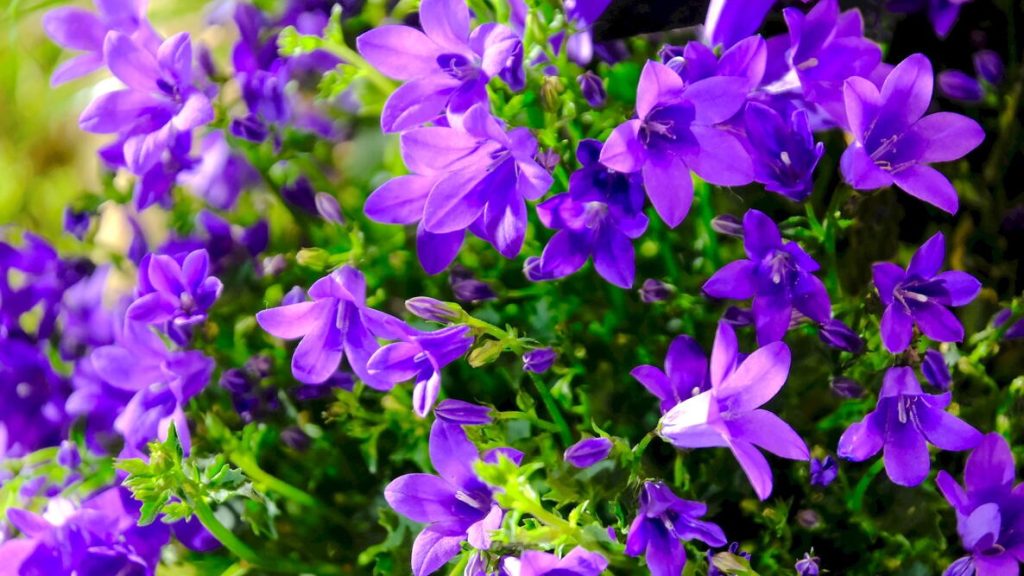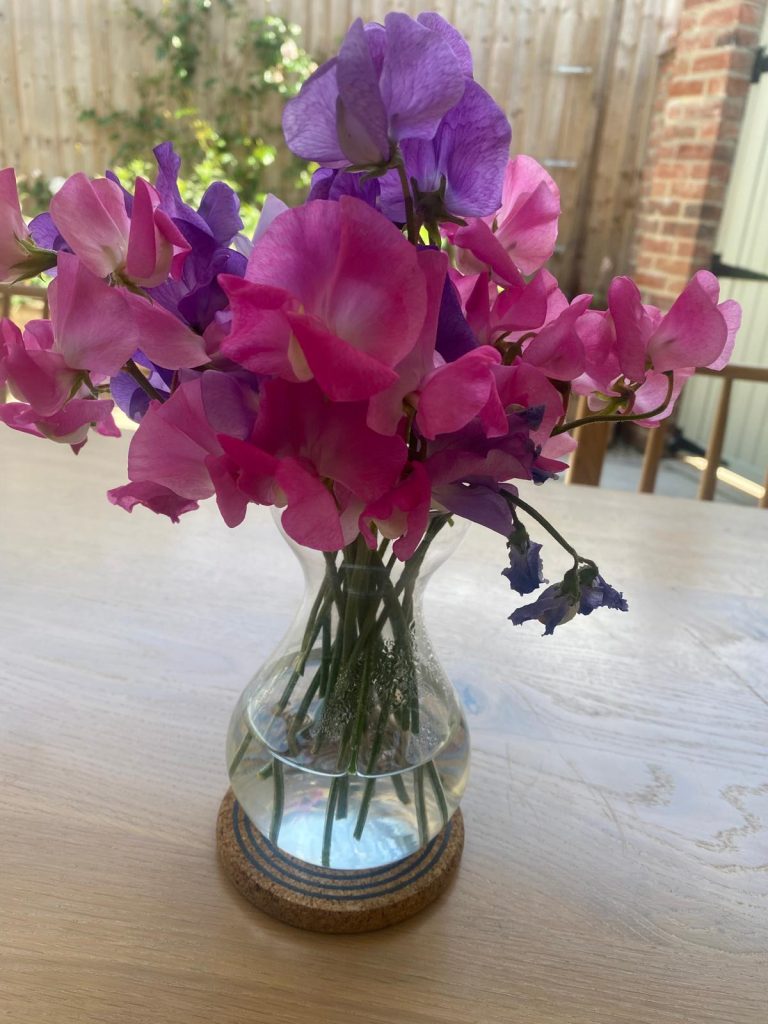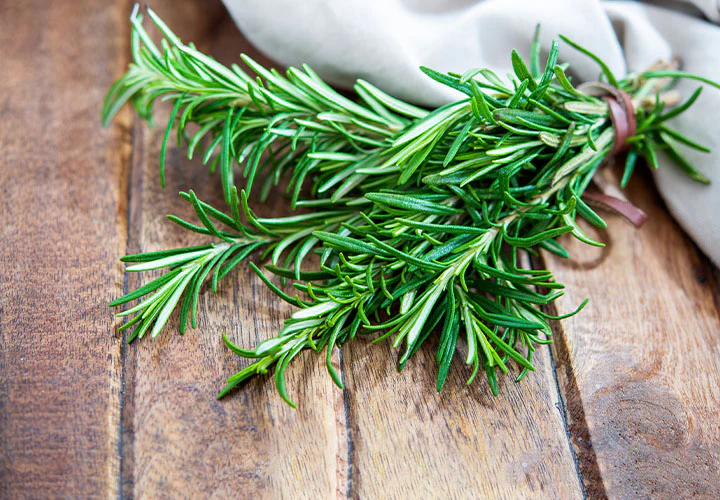Blog
-
Alwyns’ Prize for June goes to…..

One of my first blog posts was Alwyn’s Prize, about my Mother-in-Law’s habit of recognising a particular plant which was at its very best in the garden at any given time. In the intervening months I should have recognised some excellent competitors like the demure, pale beauty of early hellebores, or the huge dramatic, globes of pyrotechnic purple alliums. But I admit to being busy building Horse River Green so its only now I’m getting around to an official ceremony. This is subjective I admit but the jury considered its decision very carefully and despite some internal wrangling (which is odd because I am the jury) the decision was made. And the winner is…… the campanula.
For centuries, this exquisite, bell-shaped beauty has stolen the hearts of growers and floral artisans across the world. A native to temperate regions of the Mediterranean, Africa, and Northern and Western Asia, Campanula (also known as bellflower or Canterbury bells) has origins in picturesque country gardens and serene meadows.
The most notable characteristic of Campanula species is their tubular, bell-shaped flowers, hence from the Latin campana. The flowers are loosely clustered at the stems’ end and found in blue and purple hues, as well as whites and pinks. There are over 500 species – perennial, biennial and annual – and come in a variety of shapes – mound forming, trailing and pyramidal.
Campanulas have a long and storied history, intermingled in fable, ritual and medicine.
Historically used in folk medicine, its leaves are edible and can be consumed raw or cooked. The most popular species cultivated for its edible root is Campanula rapunculus. Rapunzel, a childhood favourite character with origins in the Brothers Grimm fairy tale was named after Campanula rapunculus. After being stolen by a sorceress as a baby, she was named “Rapunzel” after the plant that Rapunzel’s mother had so desperately craved during her pregnancy.
Campanula also has ties to ancient Greek mythology with stories of Venus, the Roman goddess of love and beauty. Venus, vain and beautiful, had a magic mirror that anyone who looked into it would appear beautiful and see nothing but beauty. One day she lost the mirror which was found by a shepherd boy who quickly fell under its spell. When he wouldn’t return it, Cupid – at Venus request – shot the shepherd’s hand with an arrow to make him release the mirror. The mirror hit the ground and shattered into small pieces and everywhere a fragment of it landed on the ground, beautiful bellflowers began to grow.
Campanula has also been used to express feelings of gratitude, humility and everlasting love. In some cultures, it is associated with death and therefore used in graveside arrangements and potted displays.
But today it’s in mounds outside our kitchen window, profoundly purple against a grey light, beautiful, gentle and uplifting. Congratulations … and thank you.
-
Sweet Peas

Francesco Cupani was born in 1657 in Mirto, a small village in the Messina province of Sicily. In 1681, at the age of 24, after initial studies in medicine, he joined the Franciscan order. After a period of teaching in Verona, he returned to his native Sicily, to the monastery at Misilmeri, a town some 9 miles from Palermo. There he continued to develop his interest in natural sciences and botany, particularly the local flora of the island, and in 1692 he became the first Director of the Misilmeri botanic garden. Despite living in monastic isolation, he managed to correspond with a number of notable scientists of his time and participated in the intellectual debate on the method of classifying plants, which would ultimately result in Linnaeus’s standard binomial nomenclature and taxonomy.
The sweet pea, Lathyrus odoratus, is native to Sicily, southern Italy and Sardinia. They are first mentioned in Cupani’s Hortus Catholicus published in 1696, and it was he who is credited with first cultivating the plants and introducing them to the world. Cupani is believed to have sent seed to a number of botanists, including the English botanists Robert Uvedale in Enfield, and Jacob Bobart in Oxford, and the Dutch botanist Jan Commelin who published a description and illustration of sweet peas growing in Amsterdam. Despite this early start, sweet pea popularity was a slow burn to say the least and a century later there were still only five cultivars available.
Over the course of the 19th Century plantsmen did begin to develop more variants, with an ultimate explosion of popularity led by the Scots horticulturist Henry Eckford (1823-1905). The most celebrated breeder of sweet peas, he transformed the plant from a floral also-ran to the ‘Queen of Annuals’, in perfecting the breeding of his Grandiflora sweet peas.
The sweet peas we generally know are easy to grow annuals, providing a huge choice of colour and heady scent. Perennial species mostly lack fragrance and are fewer to chose from. Most Lathyrus are climbing plants, so support these with canes, netting or let them scramble through a shrub or over a bank. Sow seed in either October November or late January to April and plant them out in April. If grown indoors let them harden off for a couple of weeks to prevent cold shock. Prepare the soil with plenty of organic matter and water well before planting near their supports. The RHS recommends 20-30cm apart but ours are more crowded and don’t seem to mind. Keep them well watered, tied in at first – although they’ll do the job themselves very soon – feed with Tomorite if the soil is light, and once flowering, keep picking – fresh flowers for display or removing any dead ones you’ve missed. Sweet peas will stop flowering if seedpods are allowed to develop, so keep on top of it and provide wonderful scented flowers in your house day after day.
-
Rosemary

You must have rosemary (Salvia Rosmarinus) in the garden. It is one of the most delicious and essential herbs, with wonderful scent and a luxuriant growth that works equally well in a cottage garden, within a formal structure, in Mediterranean style dry planting or in a pot. Although it originates from more balmy climes, rosemary is pretty hardy and can tolerate temperatures down to -10c. It is a rugged soul, happiest in fairly poor, well drained soils, and doesn’t demand a lot of love, save for an annual haircut to keep it compact and bushy.
First mentioned in cuneiform stone tablets as early as 5000 BCE, it likely came to Britain with lots of other good stuff with the Romans in the early 1st Century. From the Middle Ages it became a staple in English herbal gardens and texts. Sadly, Americans had to wait until the early 17th century to experience its wonders.
Sacred to the Egyptians, Romans and Greeks, it was referred to in several Shakespearean plays as a token of remembrance, a meaning continued in more modern times when worn on ANZAC Day to commemorate the slaughter at Gallipoli where the herb grows wild, and over half of the 65,000 Australian and New Zealand soldiers engaged were killed or wounded..
Given its origins, rosemary unsurprisingly features in a lot of Mediterranean recipes. This is one of the simplest, but also versatile and delicious- like the ideal husband. I can’t take credit for it. Well, I can but I shouldn’t: it’s essentially a BBC Good Food recipe with a few tweaks. But it’s so delicious and, as well as becoming a staple in our house, it brings me not a little kudos with friends, neighbours and grandchildren. And it’s not like kudos overfloweth otherwise. So, here is ‘Mark’s’ focaccia recipe.Ingredients:
500g strong bread flour
7g dried fast action yeast
2 tsp sea salt
Olive oil
Fresh rosemary (or thyme) sprigs pickedMethod:
- Tip the flour into a large mixing bowl. Mix the yeast into one side of the flour and the salt into the other, before mixing it all together. This initial separation prevents the salt from killing the yeast.
- Add 2 tbsp olive oil and 350ml lukewarm water, mixing to a slightly sticky dough. Sprinkle the work surface with flour, dump the dough onto the surface and knead for 10 minutes until the dough is soft and less sticky. I find I have to keep adding flour to the surface which I don’t think purists like but seems to work and stops everything getting really gloopy.
- Now the dough proves for 1 hour until doubled in size. I put it in a proving basket, lightly floured. We have a proving setting on the oven which works really well and sits at 40c. I’m spoiled and therefore haven’t tried proving it at room temperature or near a boiler etc.
- After the hour, oil a rectangle shallow tin (25cm x 35cm ish). Tip the dough into it and stretch it to fill the tin. Prove for another 45 minutes
- Heat the oven to 220c/200c fan/gas 7 (again our oven has a ‘bread baking’ setting but I’m not sure what is so special about it, if anything). Take the proven dough and press your fingers in to make dimples. Splash with some olive oil and water (I use fizzy water – again not sure if it makes any difference) and flaky sea salt. Push rosemary or thyme leaves into the dimples.
- Bake for 20 minutes. Then turn the loaf and drizzle a little more oil on the bottom then back in the oven bum side up for just 2 minutes more. Once done, put on a cooling rack right way up and drizzle the top with more oil and water.
As you can see mostly it’s about lots of oil and salt!
Buon Mangiare!


